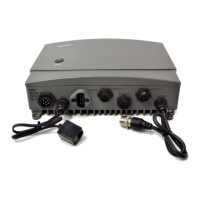3-30 Operations
1. If all Handsets are On-Hook
Handset1 Handset 2 Handset 3
2. If only Handset 1 is Off-Hook
Handset 1 Handset 2 Handset 3
3. If only Handset 2 is Off-Hook.
Handset 1 Handset 2 Handset 3
3.5.24 NMEA Operation
The RAY230/RAY230E can receive valid position and time information,
which are transmitted during a DSC Distress call. This data can be
communicated via SeaTalk or NMEA 0183 from a GPS, fishfinder, radar, or
any device that outputs or repeats GPS sentences. If the radio does not
detect the positional data, it provides different alerts urging you to find
and correct the fault or manually input the data using the radio’s L/L ENT
function, as described in section 3.5.30.3.2. Current valid positional data,
whether from external device or manually input, can be viewed using the
NAVSTAT Operation described in section 3.5.30.2.
If a GPS device is not connected via SeaTalk or NMEA, the radio emits a
5-second-long staccato alert tone and flashes the NMEA indicator 2
minutes after power up. This occurs every time the unit is turned on. The
alarm is required by safety regulations and cannot be disabled.

